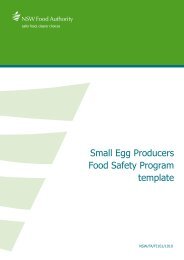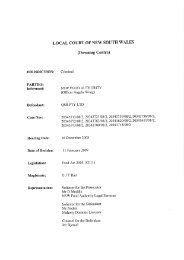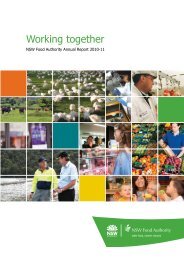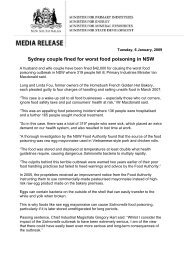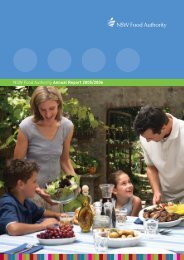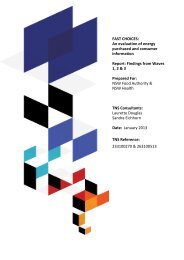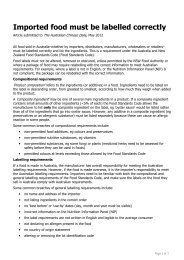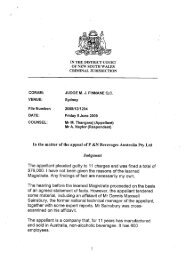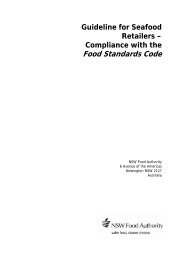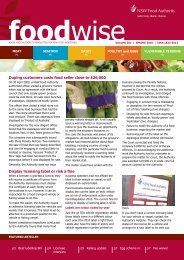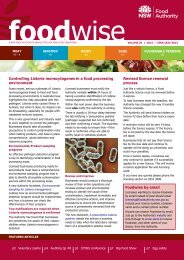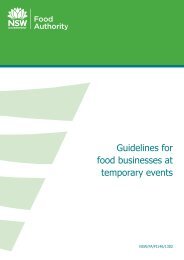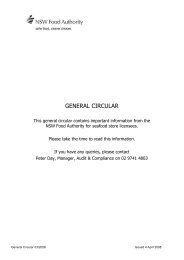Requirements for egg transport vehicles - NSW Food Authority
Requirements for egg transport vehicles - NSW Food Authority
Requirements for egg transport vehicles - NSW Food Authority
Create successful ePaper yourself
Turn your PDF publications into a flip-book with our unique Google optimized e-Paper software.
facebook.com/nswfoodauthority twitter.com/nswfoodauthority www.foodauthority.nsw.gov.au<strong>Requirements</strong> <strong>for</strong> <strong>egg</strong> <strong>transport</strong> businessesThis factsheet is <strong>for</strong> businesses that <strong>transport</strong><strong>egg</strong> products with at least 80% <strong>egg</strong> white oryolk, or both, or cracked <strong>egg</strong>s. It does notapply to businesses that <strong>transport</strong> whole <strong>egg</strong>sor dried <strong>egg</strong> products.Meet the requirements of theRegulationEgg <strong>transport</strong> businesses need to meet therequirements of the Regulation. Theserequirements include basic documentation andrecord-keeping and are outlined below.Minimum food safety requirementsProtection from contaminationEgg <strong>transport</strong> <strong>vehicles</strong> need to meet therequirements in Standard 3.2.2 <strong>Food</strong> SafetyPractices and General <strong>Requirements</strong> andStandard 3.2.3 <strong>Food</strong> Premises and Equipmentof the <strong>Food</strong> Standards Code.To comply businesses should: design and construct <strong>transport</strong> <strong>vehicles</strong> toprotect food from contamination, effectively clean and sanitise (wherenecessary) <strong>transport</strong> <strong>vehicles</strong> to protectfood from contamination, and segregate raw (eg cracked <strong>egg</strong>s) fromprocessed food (eg pasteurised pulp), andprotect food from contamination bycovering or sealing it appropriately.Traceability of unpasteurised <strong>egg</strong>products and cracked <strong>egg</strong>sThe following records need to be kept <strong>for</strong><strong>transport</strong> of unpasteurised <strong>egg</strong> products withat least 80% <strong>egg</strong> white or yolk, or both, andcracked <strong>egg</strong>s: names and addresses of the persons orbusinesses <strong>for</strong> whom the foods are<strong>transport</strong>ed, names and addresses of the persons orbusinesses (if known to the holder) thatsupplied the foods, addresses of the premises from which thefoods were collected <strong>for</strong> <strong>transport</strong>ation andto which the foods were delivered, dates on which the foods are <strong>transport</strong>ed, lot identification numbers of the foods<strong>transport</strong>ed, quantity of the foods <strong>transport</strong>ed.Temperature during <strong>transport</strong>Businesses need to maintain daily productand/or air temperature records (eg load in/outproduct and/or air temperatures, using athermometer or continuous data loggerrecorder) to demonstrate that cracked <strong>egg</strong>sand <strong>egg</strong> products with at least 80% <strong>egg</strong> whiteor yolk, or both, are being <strong>transport</strong>ed inaccordance with the requirements outlined inTable 1, or if frozen, frozen solid.Temperature measuring devices must be easilyaccessible and demonstrate accuracy of ± 1°C.6 Avenue of the Americas, Newington <strong>NSW</strong> 2127 | PO Box 6682, Silverwater <strong>NSW</strong> 1811T 1300 552 406| F 02 9647 0026 | E contact@foodauthority.nsw.gov.au<strong>NSW</strong>/FA/FI077/1407
Table 1: Transport temperature requirements<strong>Food</strong>StoragetemperatureJustificationCracked <strong>egg</strong>s < 8°C Code of Practice <strong>for</strong>the Manufacture ofEgg Products(AECL, February2008)Salmonella isunlikely to grow at



